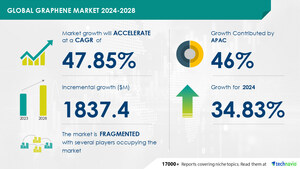NEW YORK, March 1, 2024 /PRNewswire/ -- The electric vehicle supply equipment market size is estimated to grow by USD 68.74 billion from 2022 to 2027, according to Technavio. The market is estimated to grow at a CAGR of 29.9% during the forecast period. However, the growth momentum will progress. The deployment of smart grids for EVs is an emerging trend shaping market growth. The smart grids for electric vehicles also form part of the Advanced EV Charging Infrastructure and by providing real-time information on load requirements and power quality to the operators, they support the wider deployment of variable generation technologies. Also, they are a foundation for V2G infrastructures, as they involve grid applications such as Smart Energy Metering, Supervisory Control, and Data Acquisition Systems in the area of SCADA Networks, Information Technologies, or any Communication Network. Although there are no established smart grid standards, international agencies such as the International Electromechanical Commission (IEC) and the Institute of Electrical and Electronics Engineers (IEEE) have developed many standards, including those for EVs. Furthermore, many countries are actively investing in smart grid technology and the expansion of electric vehicle charging stations will probably be driven by these developments, which, in turn, will fuel the growth of the global electric vehicle supply equipment market during the forecast period. Request a sample report
Report Coverage |
Details |
Page number |
163 |
Base year |
2022 |
Historic period |
2017-2021 |
Forecast period |
2023-2027 |
Growth momentum & CAGR |
Accelerate at a CAGR of 29.9% |
Market growth 2023-2027 |
USD 68,744.87 million |
Market structure |
Fragmented |
YoY growth 2022-2023(%) |
28.11 |
Regional analysis |
APAC, North America, Europe, South America, and Middle East and Africa |
Performing market contribution |
APAC at 44% |
Key countries |
US, China, Germany, France, and The Netherlands |
Segment Overview
Technavio has segmented the market based on type (Level 2, Level 1, and Level 3), application (Residential and Commercial), and geography (APAC, North America, Europe, South America, and Middle East and Africa).
- The level 2 segments are estimated to witness major growth during the forecast period. Level 2 charging refers to the charging infrastructure that offers power at a higher voltage (240 volts, AC) and amperage than a standard household power outlet, leading to faster and more efficient charging for electric vehicles. This category provides EV owners with a convenient and reliable charging solution for both residential and commercial use. Also, Level 2 charging stations can be installed by homeowners in their garages or parking lots, delivering an efficient and quick recharging solution for EVs. This allows them to charge their vehicles on a night basis in order to ensure that they are prepared for their daily commutes without any trouble. Such factors are expected to drive the growth of the level 2 segment in the electric vehicle supply equipment market during the forecast period.
Geography Overview
By geography, the electric vehicle supply equipment market is segmented into APAC, North America, Europe, South America, and the Middle East and Africa. The report provides actionable insights and estimates the contribution of all regions to the growth of the global electric vehicle supply equipment market.
- APAC is estimated to account for 44% of the global market during the forecast period. Technavio's analysts have elaborately explained the regional trends and drivers that shape the market during the forecast period. The high sales of BEVs and PHEVs in countries such as China, Singapore, Japan, and South Korea are majorly contributing to the growth of the electric vehicle supply equipment (EVSE) market. China is the single largest contributor to the regional EV market and also the largest seller of EVs across the globe. The rising emphasise on alternative fuel vehicles in emerging markets in Asia is acting as an enabler for the growth of the regional electric vehicle supply equipment market in the region. The growing stringency of emission norms in emerging economies is driving OEMs to expand their portfolio of BEVs and PHEVs and driving the installation of EV charging stations in the region. Download a Sample Report
The increased demand for electric vehicles
Government financing, incentives, and subsidies aimed at developing and expanding EV recharging infrastructure are the major drivers of the market's growth. Government bodies have taken various reforms and have expanded subsidies and incentives such as e-AMRIT for developing EV charging infrastructure. Similarly, standards for fuel efficiency of vehicles, recharging infrastructure, consumer tax credits, and substantial R&D support are also fueling the growth of such vehicles in the United States. Nevertheless, government help is essential for driving the sales of new energy vehicles such as BEVs and PHEVs. Government bodies are promoting the use of EVs with increasing concerns over environmental pollution and the depletion of conventional sources of energy. For the use of EV chargers, subsidies and incentives are provided by government authorities in different EVSE markets in order to boost sales of BEVs and PHEVs. The aid from governments is anticipated to drive the growth of the global EV charging station, in turn, creating demand for electric vehicle supply equipment market growth during the forecast period.
The lack of standardization of EV charging is a major challenge hindering market growth. Insights on Market Drivers, trends, & Challenges, historic period(2017 to 2021) and forecast period(2023 to 2027). Request a sample report!
Analyst Review
The market is witnessing unprecedented growth, driven by a confluence of factors ranging from technological innovation to governmental initiatives aimed at curbing environmental degradation. As the world grapples with geopolitical tensions and fluctuating fuel prices, the spotlight is increasingly turning towards sustainable solutions like electric vehicles (EVs) powered by renewable sources of energy.
Within this landscape, the global electric vehicle supply equipment market is a crucial component, encompassing a diverse array of products and accessories. From chargers to sockets, electrical circuits to communication protocols, the market caters to the burgeoning needs of EV manufacturers, EV drivers, and end-consumers alike.
One of the pivotal growth drivers in this sector is the escalating concern over environmental issues such as global warming and the carbon footprint associated with combustion engines running on petrol, diesel, and gas. As consumers become more environmentally conscious, the demand for EVs and the requisite charging infrastructure continues to surge.
Government initiatives, including subsidies and tax redemptions, play a pivotal role in incentivizing the adoption of EVs and bolstering market share. In Europe, countries like France and Germany are leading the charge by implementing progressive EV policies and investing in technological innovation. Solar-powered charging stations, in particular, are gaining traction as renewable sources of energy are leveraged to power the EV ecosystem.
Despite the promising outlook, the EVSE market faces several challenges. High costs associated with infrastructure deployment and technological advancements remain significant hurdles. Segmentation within the market, including station types such as supercharging, normal charging, and inductive charging, further complicates the landscape.
However, as consumer awareness grows and technological innovations continue to drive down costs, the market is poised for exponential growth. Residential solutions like onboard charging stations and portable chargers are becoming increasingly popular, catering to the needs of EV drivers with driver anxiety.
EV charging kiosks are also emerging as a convenient solution for both urban and rural areas, ensuring widespread accessibility to charging infrastructure. As the EVSE market evolves, it will play a pivotal role in shaping the future of transportation, mitigating environmental concerns, and fostering sustainable development on a global scale. Request a sample report!
Related Reports:
The Global Electric Vehicle Test Equipment Market size is estimated to grow by USD 117.98 million between 2022 and 2027 accelerating at a CAGR of 23.11%.
The Global Electric Vehicle (EV) Market size is estimated to grow by 25,927.15 thousand units between 2022 and 2027 accelerating at a CAGR of 37.45% during the forecast period.
Table of contents
1 Executive Summary
2 Market Landscape
3 Market Sizing
4 Historic Market Size
5 Five Forces Analysis
6 Market Segmentation by Type
7 Market Segmentation by Application
8 Customer Landscape
9 Geographic Landscape
10 Drivers, Challenges, and Trends
11 Company Landscape
12 Company Analysis
13 Appendix
About US
Technavio is a leading global technology research and advisory company. Their research and analysis focus on emerging market trends and provide actionable insights to help businesses identify market opportunities and develop effective strategies to optimize their market positions. With over 500 specialized analysts, Technavio's report library consists of more than 17,000 reports and counting, covering 800 technologies, spanning 50 countries. Their client base consists of enterprises of all sizes, including more than 100 Fortune 500 companies. This growing client base relies on Technavio's comprehensive coverage, extensive research, and actionable market insights to identify opportunities in existing and potential markets and assess their competitive positions within changing market scenarios.
Contact
Technavio Research
Jesse Maida
Media & Marketing Executive
US: +1 844 364 1100
UK: +44 203 893 3200
Email: [email protected]
Website: www.technavio.com
SOURCE Technavio

WANT YOUR COMPANY'S NEWS FEATURED ON PRNEWSWIRE.COM?
Newsrooms &
Influencers
Digital Media
Outlets
Journalists
Opted In






Share this article